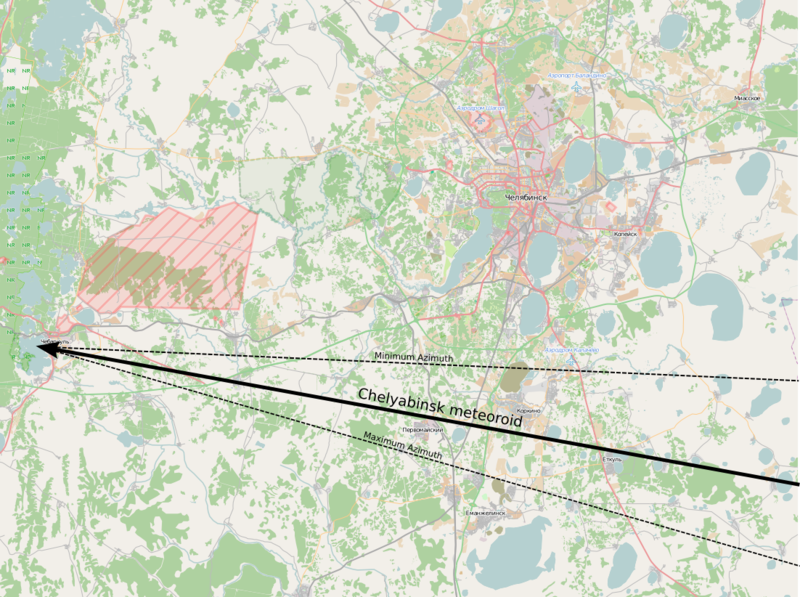Impact Events
Chicxulub Crater
"Chicxulub" is Mayan for “tail of the devil”. The impact occurred ~65 mya (Cretaceous) and is thought to be the genesis of the K-T extinction event. The estimated size of meteorite is 10 km (6 mi) in diameter, and released 4.3×1023 joules of energy (approximately 190,000 gigatons of TNT) on impact.
The crater was discovered in 1978 by Glen Penfield (Petroleos Mexicanos). The evidence for a crater under the northern Yucatan Peninsula included:
- 1960s gravity map
- Exploratory holes
- Andesite at a depth of 1.3 km
- Shock-metamorphic materials

It has been suggested that the meteor that formed the Chicxulub crater actually broke apart during enter and formed not one but several impacts. This is called the Multiple Impact Theory. There are several craters throughout the world that date to the same time as the Chicxulub crater:
- Boltysh crater (24 km diameter, 65.17 ± 0.64 Ma old) in Ukraine

- Silverpit crater (20 km diameter, 60-65 Ma old) in the North Sea

- Eagle Butte crater (10 km diameter, < 65 Ma old) in Alberta, Canada (subsurface)
- Vista Alegre crater (9.5 km diameter, < 65 Ma old) in Paraná State, Brazil
Numerous extinctions have been dated to this time. On land, there was a preferential survival of species not dependent upon plants such as carnivorous dinosaurs and some birds & mammals. However, as the herbivores died, so did the carnivores. Some studies suggest that egg-laying animals that cared for their young survived while those who laid eggs and then left them did not. The oceans saw the extinction of many species of phytoplankton, nearly all sea reptiles (mosasaurs and plesiosaurs), and ammonites, to name a few.
Wilkes Land Crater
The Wilkes Land Crater is a ~300 miles wide impact crated that formed about 250 million years ago. It may be the cause of the Permian-Triassic extinction - also called “The Great Dying” as most life on land and in the oceans wiped out. It has also been speculated to be the possible cause for the break-up of Pangaea.

image from: Giant Crater Found: Tied to Worst Mass Extinction Ever by Robert Roy Britt, Senior Science Writer | June 01, 2006
The Tunguska event
On June 30, 1908, an explosion of an “asteroid or comet 6 to 10 kilometers above the Earth's surface” of Tunguska, Siberia. The explosion felled 80 million trees over 2,150 km2 and may have created a lake.

Tunguska is conveniently near nothing, so it took a while for scientists to reach the impact area. The Leonid Kulik Expedition investigated the site in 1927. They recorded eyewitness testimonies, and did a reconnaissance of area - but found no evidence of meteorite fragments. So, then, what caused the explosion?
Chelyabinsk meteor
On February 15, 2013, a superboide exploded over Chelyabinsk, Russia. It's velocity was +40,000 mph and it exploded 29.7 km above Earth. The event was witnessed by thousands, many of whom recorded the bright flash of light and explosion and then uploaded it onto social media sites.

image: Chelyabinsk meteor (Wikipedia)
A bolide is a meteor or asteroid that explodes above the Earth's surface. A superbolide is a bolide that has an apparent magnitude of −17 or brighter. The animated gif below shows the path the Chelyabinsk bolide took as it entered Earth's atmosphere.
_-_Meteorite.gif)
image: Chelyabinsk meteor (Wikipedia)
Modern technology gives us the advantage of being able to trace the trajectory of the meteor, in addition to other parameters, that we cannot do with past events. Below is an image that was created to show the meteor's path in relation to the ground, in addition to a strewnfield map of recovered meteorites.

image: Chelyabinsk meteor (Wikipedia)

image: Chelyabinsk meteor (Wikipedia)
With this information, we can revisit the Tunguska event. While we may never know for sure, it is now thought that a bolide is what caused the explosion. This would explain the felled trees and the lack of an impact crater.
<< back |
||
